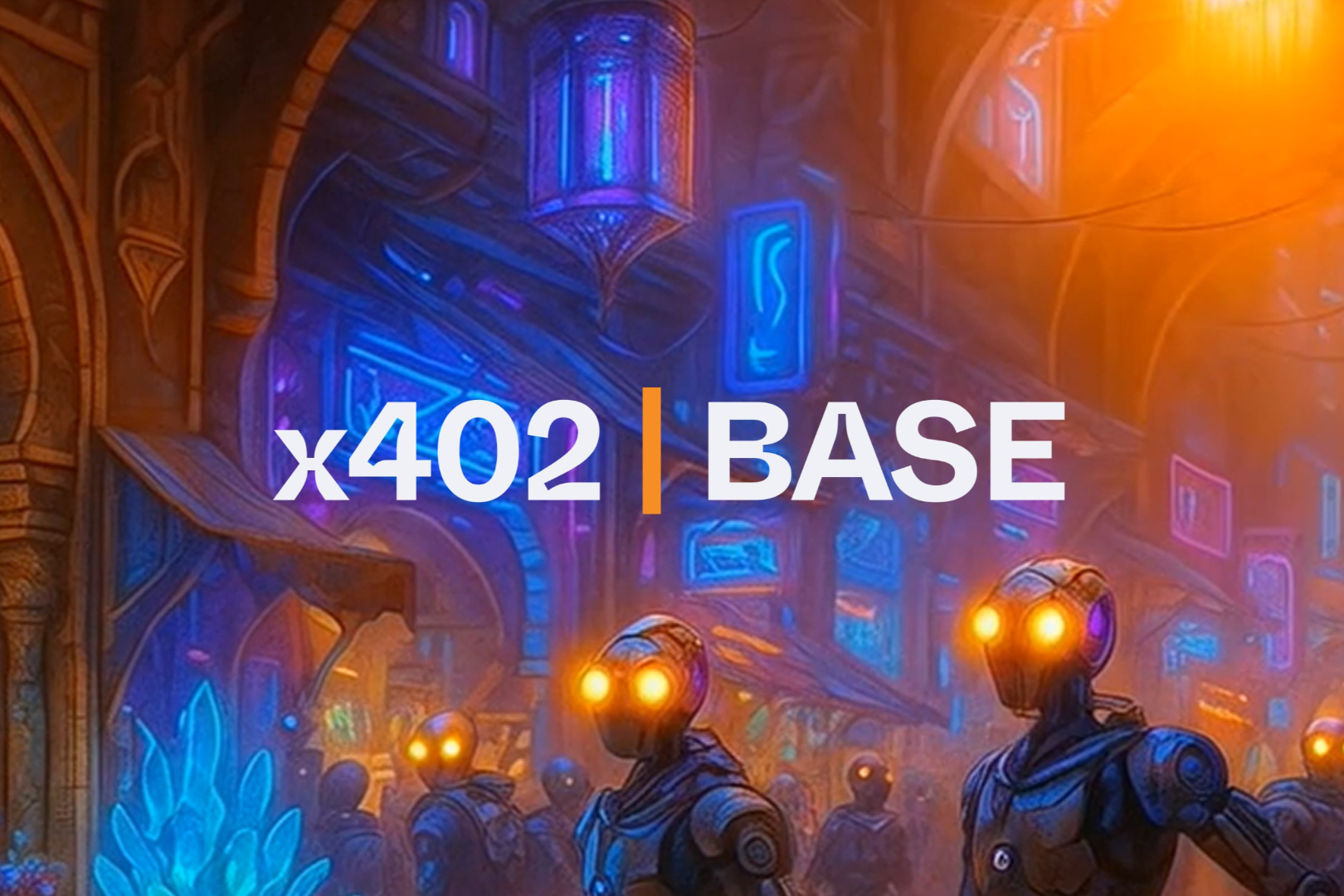Original |
Author | Husband How
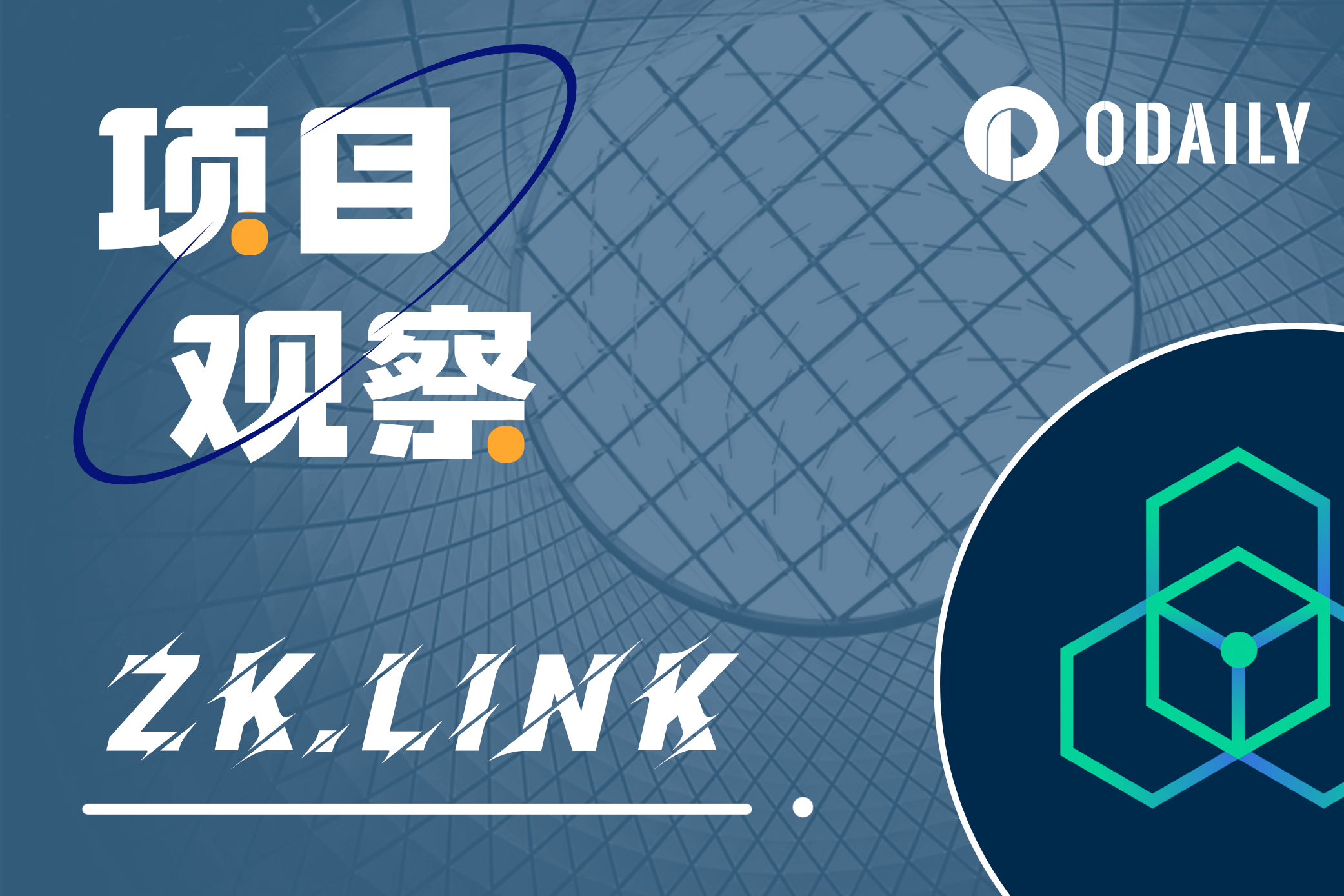 When a top investment institutionParadigm reveals 10 potential trendsFinally, the multi-chain interconnected network centered on Rollup triggered my thinking. The concept of multi-chain interconnection has been discussed in the past few years. From the interconnection between public chains to the interconnection between L2 today, the history is always surprisingly similar.
When a top investment institutionParadigm reveals 10 potential trendsFinally, the multi-chain interconnected network centered on Rollup triggered my thinking. The concept of multi-chain interconnection has been discussed in the past few years. From the interconnection between public chains to the interconnection between L2 today, the history is always surprisingly similar.
The industry has at least determined one basic direction, which is that a multi-chain universe based on Ethereum is gradually taking shape. Although it still needs to be verified whether it is centered on L2 or connects the entire ecosystem through the Rollup method, one thing that is certain is that the future narrative scenes of related projects will be large-scale and have room to breed the next Alpha.
at this time,zkLinkBecause a new round of loyalty point acquisition rules was announced and came into our sight. When Odaily learned about its specific rules, it conducted research on zkLink and found that it could be related to the potential trend centered on Rollup described by Paradigm.
Project Overview
zkLink is a multi-chain ZK-Rollup trading infrastructure designed to solve the problem of insufficient liquidity and EVM-based L1 and L2 interoperability in transactions.
● Liquidity: The current status quo is that different DEXs on each chain have their own liquidity pools, and the liquidity in the pools is relatively closed.
For example, if a user wants to use Token 1 on chain A to purchase Token 2 on chain B, the normal steps are to exchange Token 1 on the DEX of chain A for a stable currency, and then cross to chain B through a cross-chain bridge. Exchange Token 2 on the DEX of chain B. This process not only has high gas costs, but also lacks safety. zkLink serves as a middleware to deploy contracts on different chains. Users with the above requirements can complete these operations directly through DEX on zkLink, using zero-knowledge proof as transaction proof, and lightweight oracles are used between some networks to ensure the validity of transactions. performance; at the same time, use zkRollup to reduce Gas costs.
● Interoperability: zkLink is the inter-chain transaction middleware for the Ethereum multi-chain universe. From the perspective of EVM-based L1, zkLink belongs to L2. From the perspective of L2, zkLink belongs to L3. The boundaries of the two overlap.
Currently, zkLink supports most EVM-based L1 and L2 such as Ethereum mainnet, BNB Chain, Polygon, Avalanche, zkSync, Starknet, Arbitrum, Optimism, etc.
Technical realization
The technical implementation of zkLink is mainly based on two technologies: ZK-Rollup and zkSNARKs. ZK-Rollup technology aggregates transactions on multiple chains and submits a summary of all transactions on the chain, thereby reducing the amount of transaction data and computing costs. zkSNARKs technology is used to compress transactions and ensure the correctness of transaction execution, while protecting the privacy of transactions.
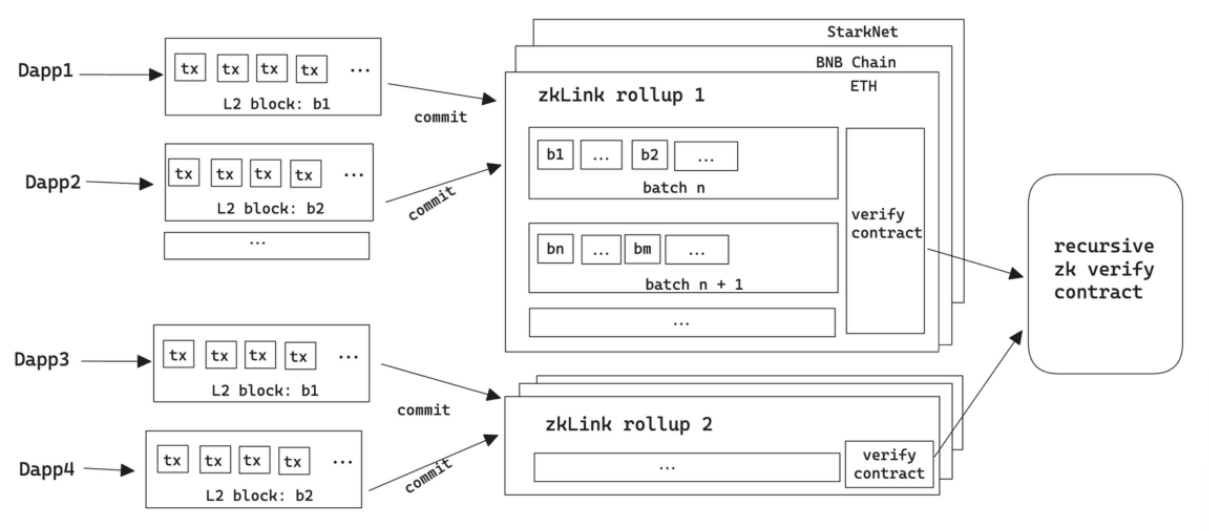
According to the zkLink network flow chart:
• Multiple DApps can share a Rollup state to achieve combination and cost-effectiveness, and the specific ratio needs to be based on the actual situation.
• zkLink will deploy multiple Rollup states to improve performance. Many Rollup states do not directly share the same liquidity pool.
• DApp acts as a sequencer and takes on the responsibility of sorting transactions. DApps need to be designed to be protected against MEV risks.
• Numerous Rollup states can further compress costs through recursion curves, thereby improving the running speed of the network.
zk-Rollup for zkLink
A normal zk-Rollup has three phases that run sequentially: a commit phase, a proof phase, and an execution phase. zkLink adds a synchronization phase between the proof phase and the execution phase. Since zkLink is a multi-chain unification, the function of the synchronization phase is to unify the states of different chains.
The synchronization phase is the processing process of the oracle network, and its function is to promote the exchange of the final roots between different chains, and compare whether the final roots of the two chains are consistent. The figure below is the Rollup process of zkLink.
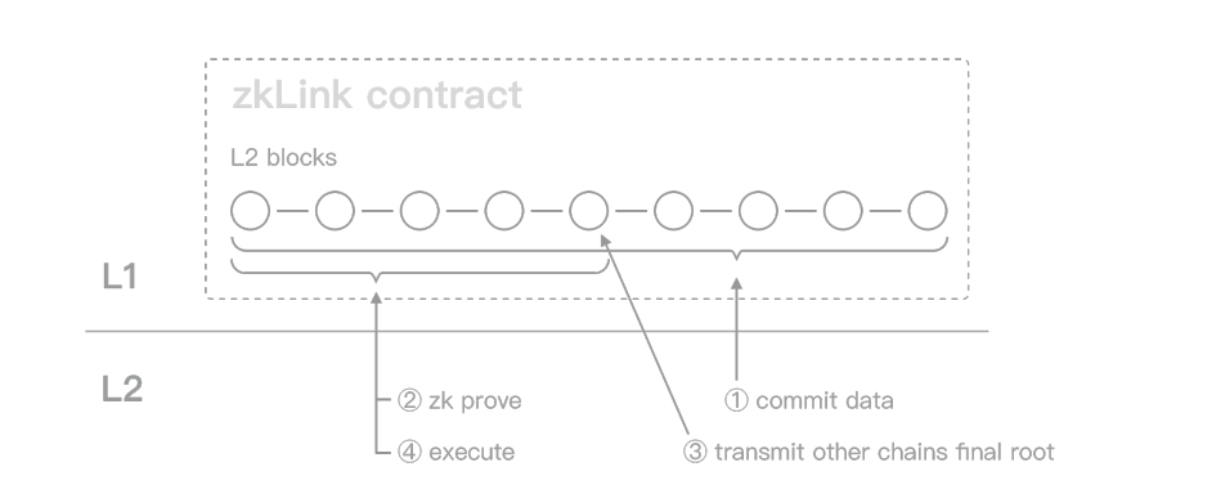
zkSNARKs for zkLink
zkLink ensures the correctness of offline status and transaction validity through zkSNARKs, verifies the limited nature of offline status through zero-knowledge proof, and ensures transaction validity by introducing a lightweight oracle network into specific network requirements.
Application Scenario
zkLink has potential in multiple application scenarios. The official scenario is as follows:
● An order book-based decentralized exchange for multi-chain atomic swaps: zkLink achieves seamless multi-chain atomic swaps by aggregating orders on different chains.
● Multi-chain AMM curves: zkLink supports AMM curves on multiple chains, providing a high-performance and low-cost asset trading experience.
● Issuance and bridging of chain-wide universal fungible tokens (OFT): zkLink allows the aggregation of tokens issued on different chains, eliminating cross-chain risks and expensive bridging fees.
● Multi-chain NFT casting and trading: zkLink provides the function of multi-chain NFT casting and trading, providing greater liquidity and interoperability for the NFT market.
We believe that in addition to the above-mentioned official application scenarios, zkLink should be integrated with the current AA wallet. As an intent-based component, the AA wallet can cooperate with the zkLink multi-chain transaction unification protocol to form a one-stop transaction experience. Users only need to express The ultimate goal is to ensure the correctness and stability of the intermediate process in a zk way. This approach lowers the barrier to entry for new users.
token economy
zkLink’s utility token and governance token is based on ERC 20 ZKL, which has not yet been allocated or announced details (mainnet is not yet live).
ZKL has the following functions:
1. zkLink block fee: as a payment token for DApps to access zkLink services and pay for network block space usage fees. When the dApp server submits a block to the zkLink contract, it needs to use ZKL to pay the validator service fee, which is calculated based on the unit price and the sum of the transaction units in the block.
● DApp needs to mortgage ZKL to gain access to the management contract.
● Validators also need to stake ZKL as a security deposit, and get ZKL as a reward by generating zero-knowledge proofs.
● Users who hold ZKL can also obtain privileges and special benefits, such as transaction fee discounts.
2. Governance: ZKL holders can mortgage ZKL to obtain veZKL to initiate proposals and vote on proposals to participate in the governance and development of the protocol.
Airdrop Mechanism - Loyalty Points
at present,zkLink Launches New Loyalty Score Mechanism on Galxe, is expected to start in the fourth quarter of this year. This loyalty point will be used as the standard for the airdrop. According to the image below, what is currently displayed on Galxe is the point rewards from previous activities.

The way to obtain loyalty points is based on the completion of relevant tasks, and the previous points are still being counted. The new event will officially start in the fourth quarter of this year, and specific rules have not yet been announced.
ecological status
Currently, zkLink is in the test network stage, and the DApps on the chain include ZKEX, zkJump, and OpenWorld.
ZKEX It is the first decentralized multi-chain order book exchange based on zkLink. (beta stage)
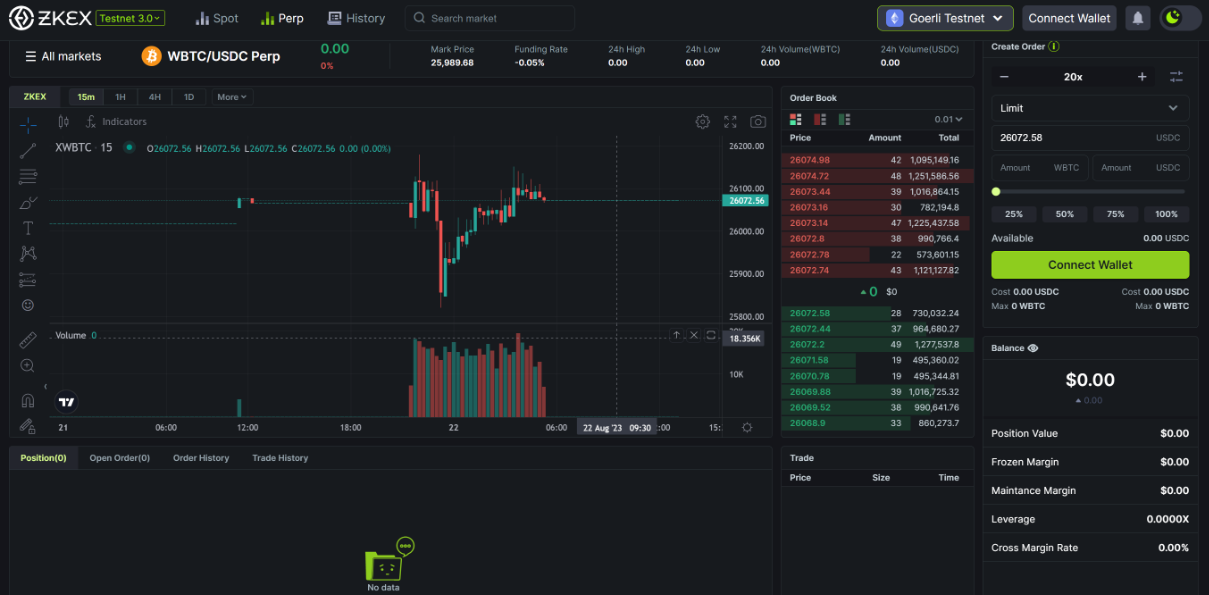
zkJumpIt is a cross-chain bridge based on zkLink and currently supports 12 chains including BNB Chain, Avalanche, zk-Sync, Starknet, and Optimism. (beta stage)
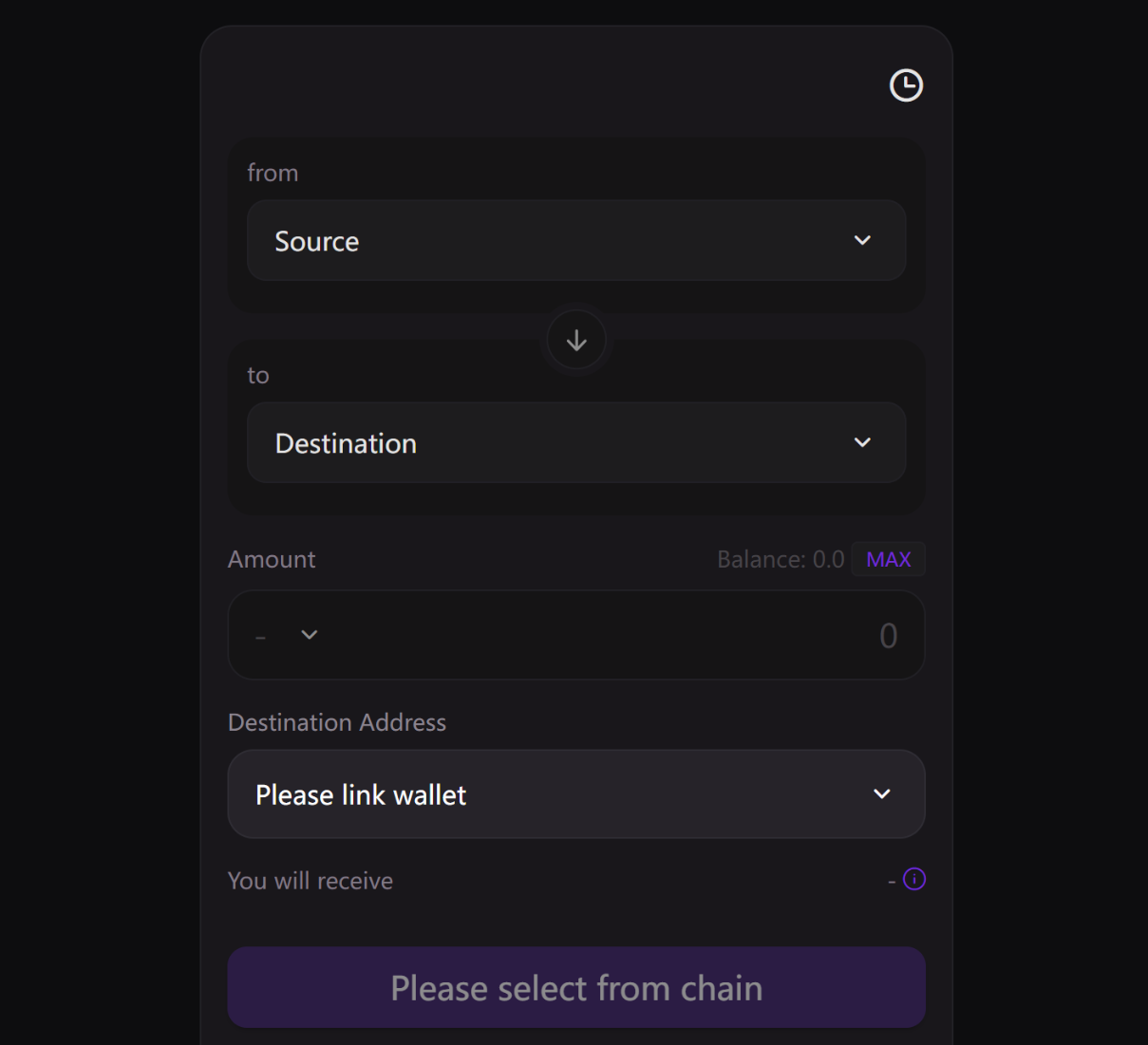
OpenWorldIt is a multi-asset (RWAcrypto) decentralized derivatives exchange (testing phase) based on zkLink.
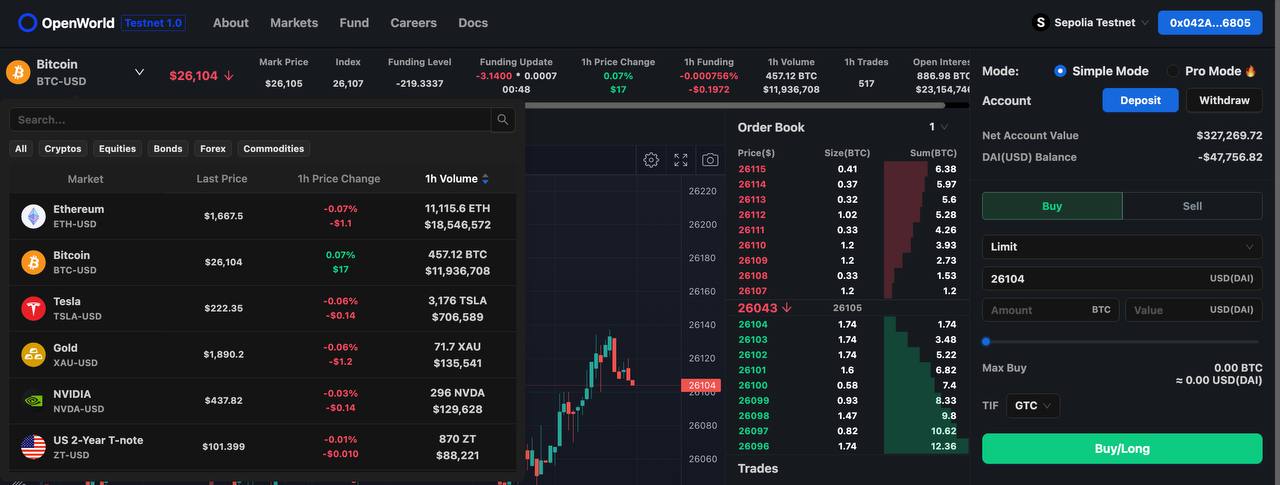
Since zkLink has not yet been officially launched, the ecological construction is still in a relatively early stage. However, according to the operating process of the zkLink network, it may be relatively difficult to build DApps on zkLink. After all, some DApps are required to act as the sequencer function of zkRollup.
Competitive product comparison
zkLink is positioned as a middleware for multi-chain interconnection related to Ethereum. It realizes transaction interconnection through zkSNARKs and zkRollup. It is essentially part of the cross-chain track. Layerzero is currently developing well in this track, but the implementation methods and paths of the two , the functions are different.
As a general cross-chain infrastructure, Layerzero uses relays, oracles, and Endpoints (contracts deployed on each chain) as tools for cross-chain transmission. The relay is responsible for transmitting the transaction proof on the chain, the oracle is responsible for reading the block header information of the source chain and transmitting it, and the Endpoint is responsible for serving as the endpoint for receiving or transmitting.
● Pack the data and destination to be delivered to the oracle and repeater through the Endpoint of the source chain.
● The oracle machine reads and confirms the block header. After the oracle machine determines that the block has gone through several block confirmations on chain A, it sends the block header to the Endpoint on chain B.
● The Endpoint on the target chain asks the relay through the received block header, and the relay receives the transaction proof of the source chain.
● After the verification under the chain is passed, the oracle machine and the relay will send the relevant transaction information to the target chain to complete the cross-chain communication.
Layerzero transmits block header information and transaction proof separately to achieve relatively secure cross-chain communication. The risk here is to ensure that relays and oracles do not collude, which depends on the degree of decentralization of the two.
Through the above introduction to Layerzero, although both place contracts on different target chains to collect transaction proofs, zkLink is more biased towards the application layer to improve interoperability between L1 and L2. Layerzero, as L0, is responsible for the synchronization between chains, etc. The focus of the two is different.
some thoughts
What does Paradigm mean by a Rollup-centric multi-chain internet?
Regarding multi-chain interconnection, due to the slow speed of the Ethereum main network and high gas fees, everyone wants to change it through multi-chain interconnection. In the past few years, projects such as Cosmos and Polkadot have attracted much attention, but so far, the ecosystem is still lacking. When L2 develops, the demand orientation changes from the interconnection between L1 and L1 to the interconnection between L1 and L2, and between L2.
Therefore, I think the current mainstream direction of Web3 is the interconnection of the multi-chain universe (based on EVM or L2) with Ethereum as the core. For the interconnection centered on Rollup, zkLink explains that it uses Rollup as a tool to package the transactions of each chain into the Rollup state of zkLink to realize the unification of the two based on zkLink; to increase the correlation between L1 and L2 and improve the mutual Operability, lowering the threshold for new users to participate.
Finally, use a metaphor to describe the role of zkLink, as the end of this article:
If the Ethereum multi-chain universe is described as an archipelago, zkLink is equivalent to a ship. It only needs a dock on each island to be responsible for the connection between each island.



